This is a Review of Audio-Technica ATH-R70x open back studio headphones. http://www.audio-technica.com/cms/headphones/f39784ce643a82e6/index.html, available on amazon: http://www.amazon.com/Audio-Technic...ck-Headphones/dp/B00SKVNS00/?tag=vectron00-20
I can’t imagine a better way to wrap up a series of my recent Audio-Technica reviews, featuring an impressive lineup of M50x, M70x, and MSR7, than by looking into their latest professional open back R70x headphones. In the past year AT has been on a roll with a lot of new releases, everything from in-ear to full size, and sometime it could be confusing and even overwhelming when you are presented with all these choices. Fortunately, AT simplified this decision task by offering their new full size headphones each with a distinct sound signature to suit different listening needs. Let me first take a closer look at R70x design and sound characteristics, and follow it up with a comparison to other models. Without a further ado, here is what I found.
Arrived in a rather large box, similar size to the latest M-models, the main focus of the cover image was to showcase the back of R70x earcup design. A mesh grill is very common in open back headphones to bring out characteristics of an airy sound, but AT went an extra mile to make this grill more transparent for a better visibility of internal design pattern. Otherwise, there is not much writing on the cover, just a bold image with a clear statement. Turning box to the side reveals another very interesting design element I haven’t seen before, a headband with a spring-loaded wing mechanism (more about it later). The back of the packaging box reveals a plethora of info about the design and sound signature (btw, found to be quite accurate – not the usual marketing hype), description of included accessories, and a detailed spec. I had to do a double take when I read 470 ohm driver impedance, but trust me – it’s not a typo.
Under the cover, you will find R70x in a foam egg crate setting with cutouts for earcups and headband wings. With this “egg crate” removed, there is a slim accessories box built into the base of this crate. It's a rather simple packaging but it felt already "airy" light and still perfectly secure!
Unboxing.
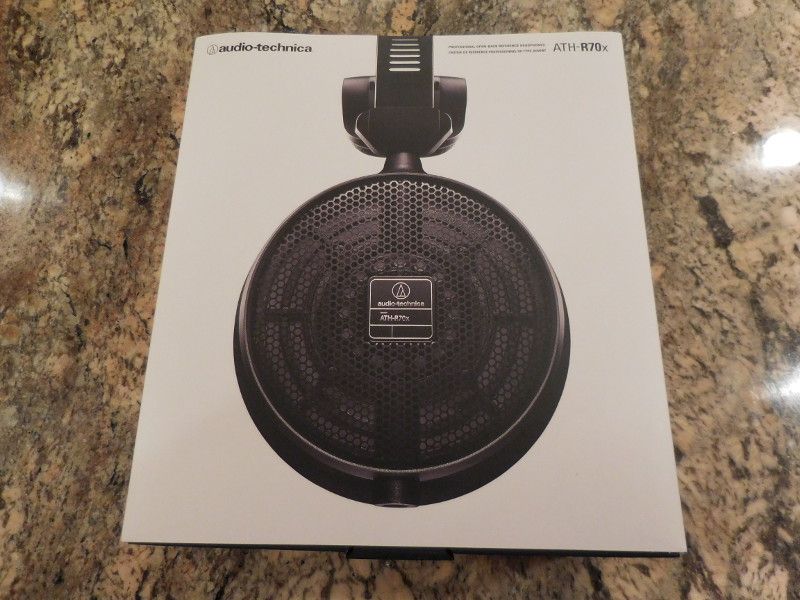

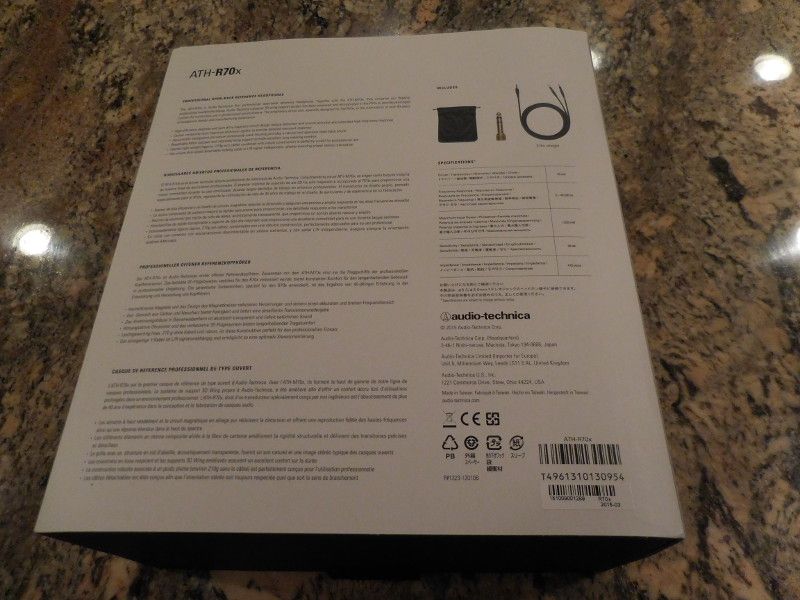
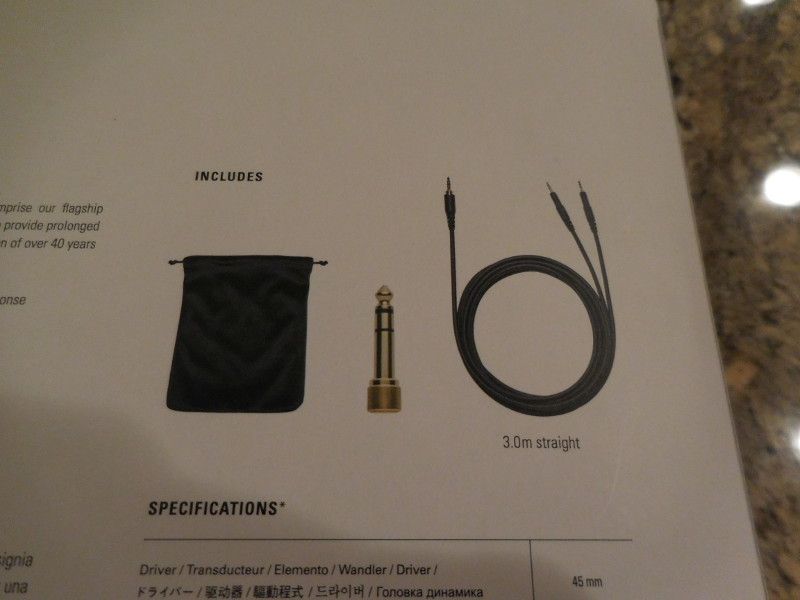
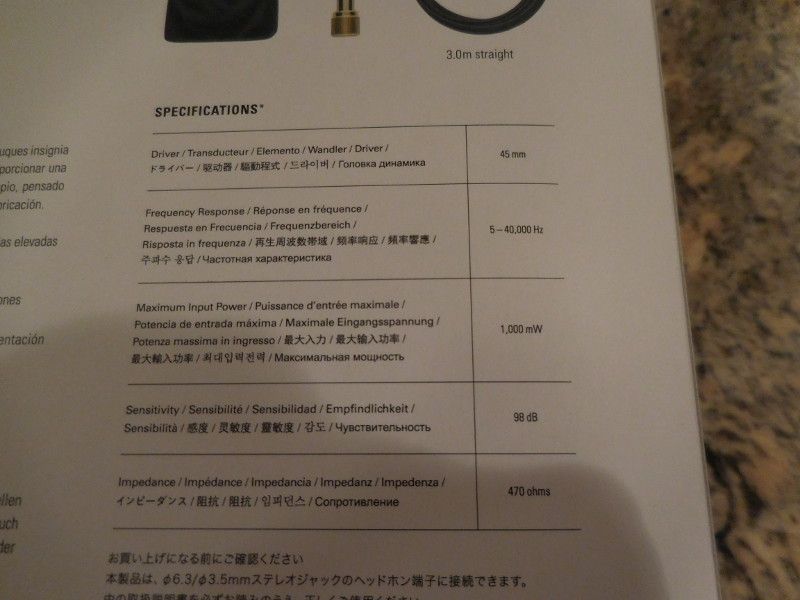
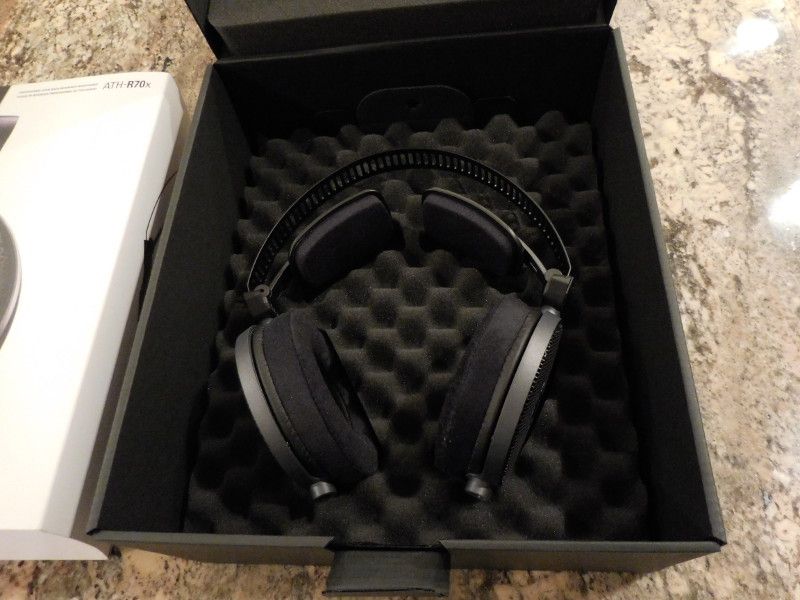
Moving on to accessories, you will find a straight 3.0m audio cable and 6.3mm adapter, and also a soft storage bag. Though it's rare to see 1/4" adapter nowadays, keep in mind these headphones are intended for professional use where pro amps and some outboard gear still uses 6.3mm headphone outputs. The same deal with a cable, it's rather long for portable use and more appropriate for desktop or studio application where you don't want to be restricted by a typical short 1.2m cable intended for a smartphone or DAP use. Still, if you want to take it on the go, maybe use a velcro to make it shorter or look for 3rd party replacement cables. The connector is their typical 2.5mm TRS with a twist-on lock, but there is a special "twist" to it. The cable splits going to L/R earcups and each connector is perfectly symmetrical so there is no designated Left or Right sides on the removable cable. Cleverly designed, each side of the cable has TRS connector with L/R/Gnd, and L/R earcups make contact only with corresponding channel. You can flip cable around and it still works correctly. My only gripe here, L/R markers inside of headband are very hard to spot.
Oh, and the storage bag... It has been a consistent "negative" comment in most of my AT full size headphone reviews (except for M70x), why not a hard shell case?!? So many headphones with a sub-par performance come with awesome storage cases, but AT with a stellar audio performance leaves storage to just a bag. In case of R70x, it's actually A BIG deal because these headphones don't fold flat, earcups swivel just a bit along y-axis for a more comfortable adjustment, but they don't swivel full 90deg for a compact flat storage. I was able to stuff R70x in the provided bag and it's actually quite a nice soft draw string pouch, but I would have to find an aftermarket case for a more secure storage if I want to transport these outside of the house.
Accessories.
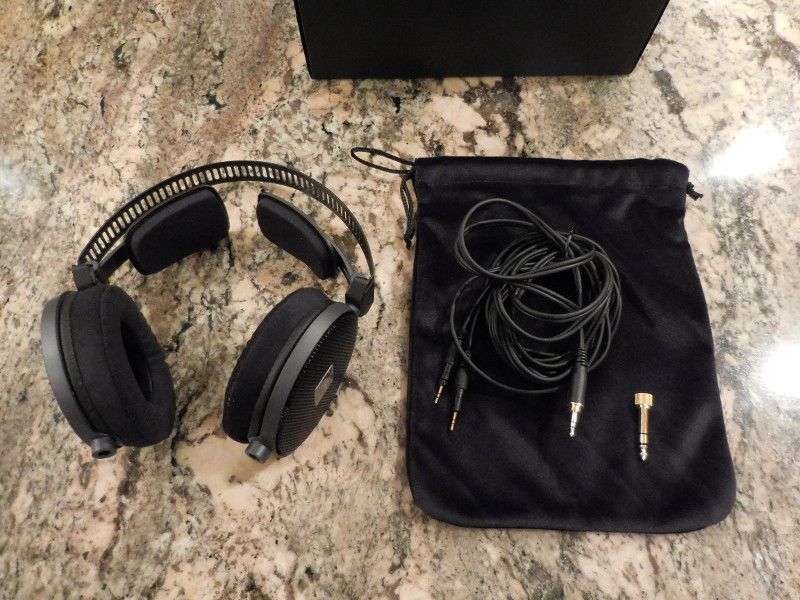
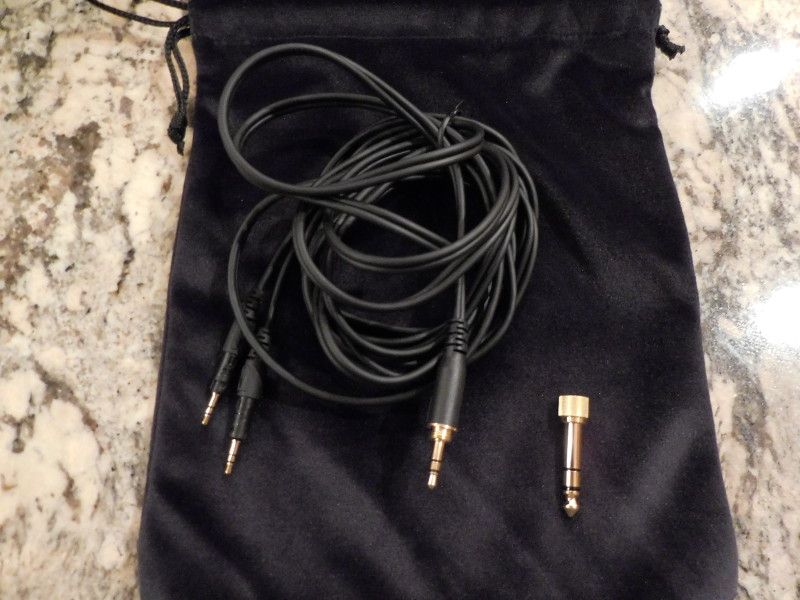
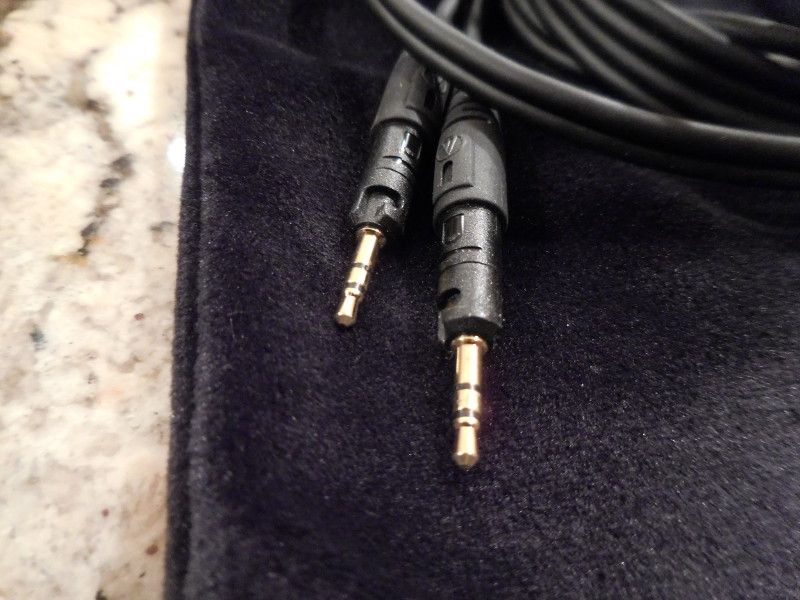
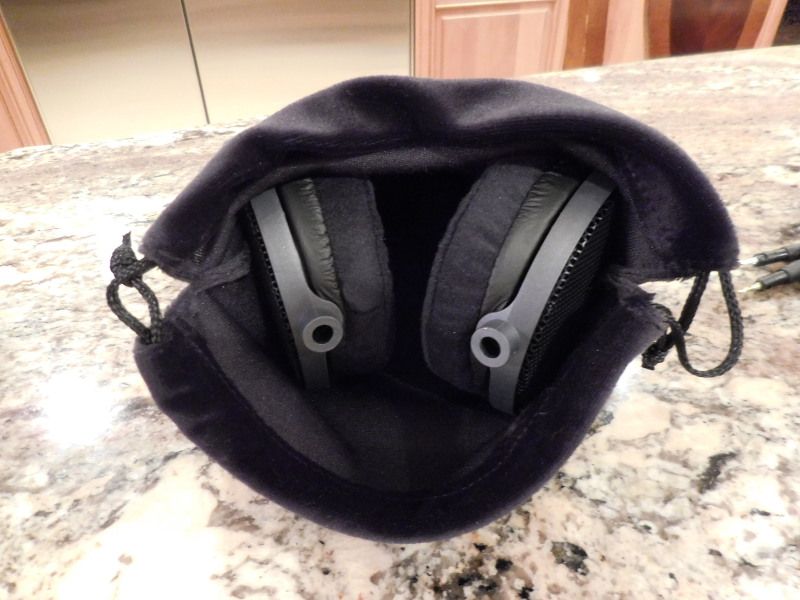
I already mentioned a little bit about the design since it's a focus of the cover box - a beautifully crafted "transparent" aluminum honeycomb mesh covering the back of earcups and revealing the inside design. I absolutely LOVE this look which serves both aesthetic purpose and acoustic purpose to enable 3D open back expanded sound. The actual housing around it is made of a super lightweight carbon composite resin to improve structural rigidity while also providing a detailed transient response.
The earpads are made from a soft breathable fabric material which doesn't get hot or sweaty during extended listening session. They are very comfortable, plush, and have enough depth for my ears not to touch driver cover inside. The base of earpads is made from pleather and earpads are attached to the earcup slightly angled for a better seal behind your ears. The earcup attachment to the headband is at a single point with a restricted small degree of vertical swivel which helps in a more comfortable fitment around your head. Add to that a balanced clamping force from a steel spring headband, which btw I was able to bend/expand just a bit by applying some extra pressure to it, and at a about 210g of weight these were the most comfortable feather-light full-size headphones I have ever experienced.
Some might consider 210g is not feather-light relative to small IEMs, but for a full size headphones with a perfect distribution of weight - you can hardly even feel them. Another important factor of this comfortable fitment is their unique wing support. Again, this was a new one for me since I'm used to a traditional headband design with a height adjustment where the yoke attached to earcup extends to adjust to my head size. Here you have a spring-loaded short arm with a small swivel foam pad which self-adjusts to a perfect fitment. This way only foam side of those pads make a contact with a top of your head, headband itself is up in the air.
Design.
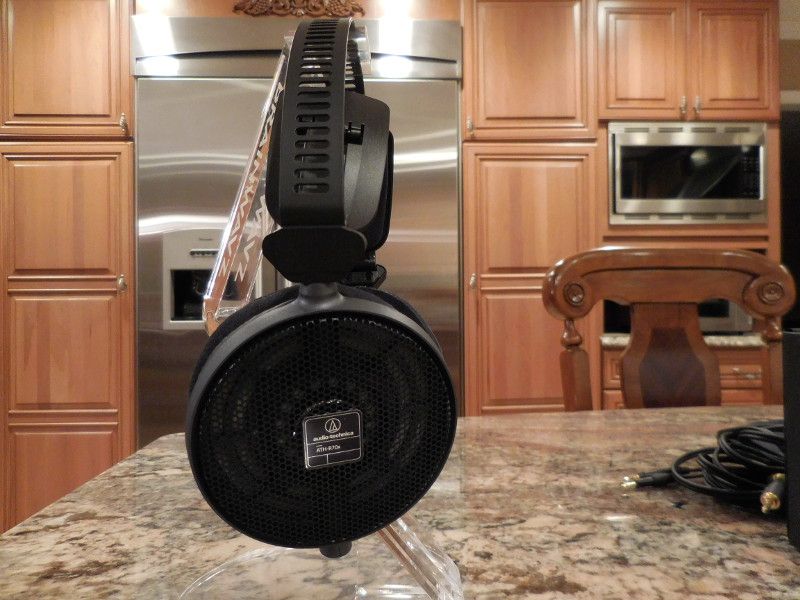
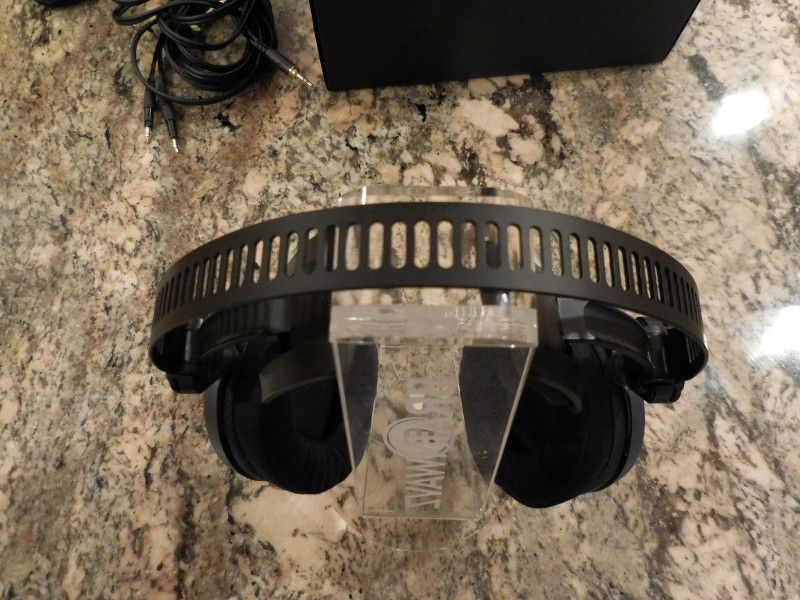
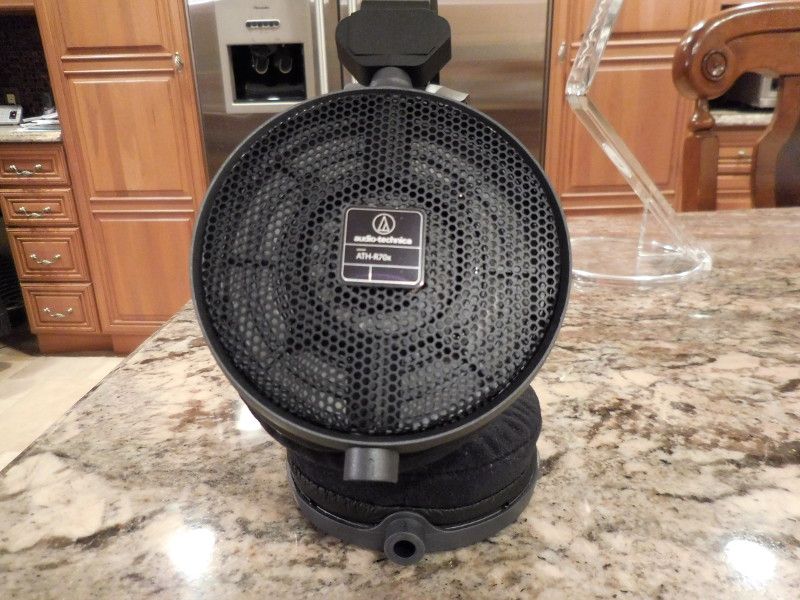
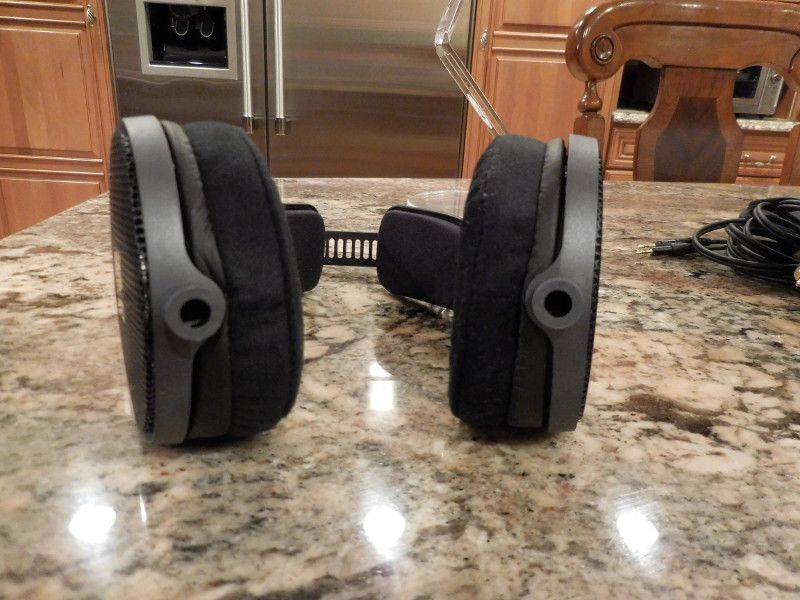
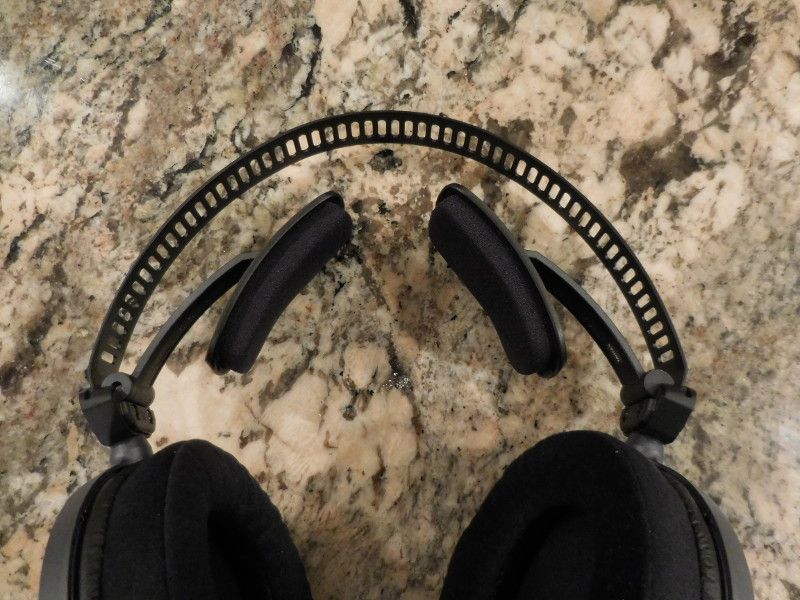
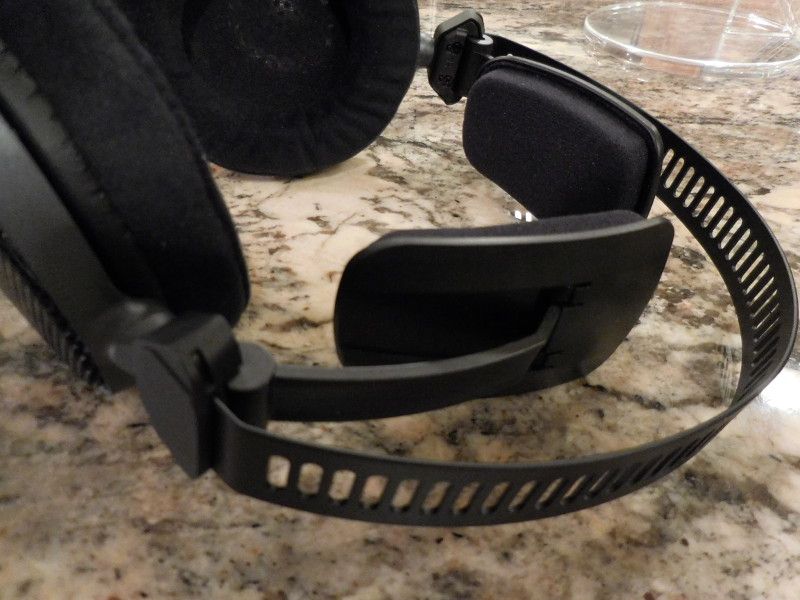

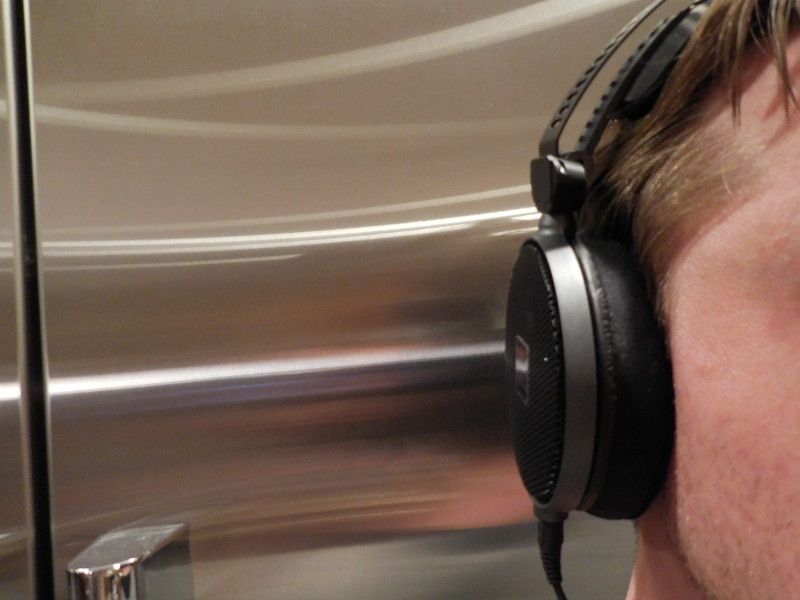
Audio-Technica labels R70x as their first pair of professional open-back reference headphones with high-efficiency magnets and pure alloy magnetic circuit design which reduces distortion and ensures accurate and extended high-frequency response. What does all this translates to? I'm hearing a neutral sound signature with a natural tonality and a very accurate retrieval of details, a great extension at both ends of the spectrum, and very non-fatigue sound (no sibilance or harsh analytical brightness). I know it's a mouthful, but I just never heard anything that sounded so crystal clear, accurate, and natural, and at the same time enjoyable for extended listening period. There are no cuts or boosts, no extra warmth of low end or extra sizzle at top end, just accuracy and quality.
Starting with a low end, there is no lack in bass response though it's more about quality than quantity. The bass does extends down to sub-bass level which is nicely balanced with mid-bass and both of which have a high level of accuracy with quantity approaching neutral level where you hear the bass rather than feel it, yet still it's tight and well controlled. Nothing is exaggerated, nothing spills into mids, and it's surgically separated from the rest of the frequency spectrum.
Mids are crystal clear, surprisingly not as thin as I expected with just a touch of warmth in lower mids to give them some body and high level of detail retrieval without too much of analytical brightness. Vocal delivery, both male and female, is crisp and organic.
Treble extends high up with a very crisp and clear delivery of sound that is not too harsh or sibilant. Any instrument that falls within treble range sounds natural and transparent, absolutely no harsh peaks.
With a help of open-back design, soundstage is open and airy, with a great width and depth. Sound separation is phenomenal with layering/separation of each individual instrument and vocals that could be easily singled out in a mix. Also, the imaging is very accurate with a precise position of every sound in the open 3D space. For studio mixing and mastering - this is a valuable tool that can substitute (though not replace) monitor speakers. At the same time, isolation is very poor since an open back design will let all sounds in from outside. The same is the other way around where sound leakage is very noticeable since there are no boundaries to confine a sound within earcups.
Amping is definitely something you need to consider, though I found a number of my portable DAPs to provide plenty of power to drive R70x to a comfortable listening level. For example, N6 and X3ii had no issue what so ever, while AK120ii and my Galaxy Note 4 needed to get closer to a volume ceiling level in order to drive them loud enough. The reason why I found amping to be necessary even in cases where my audio source had enough power is because it's not just about "loudness" but the actual "power" to drive it with authority to a full potential! The best pair up I found was with Cayin combo of N6 + C5 where soundstage expanded even further and bass became tighter and punchier.
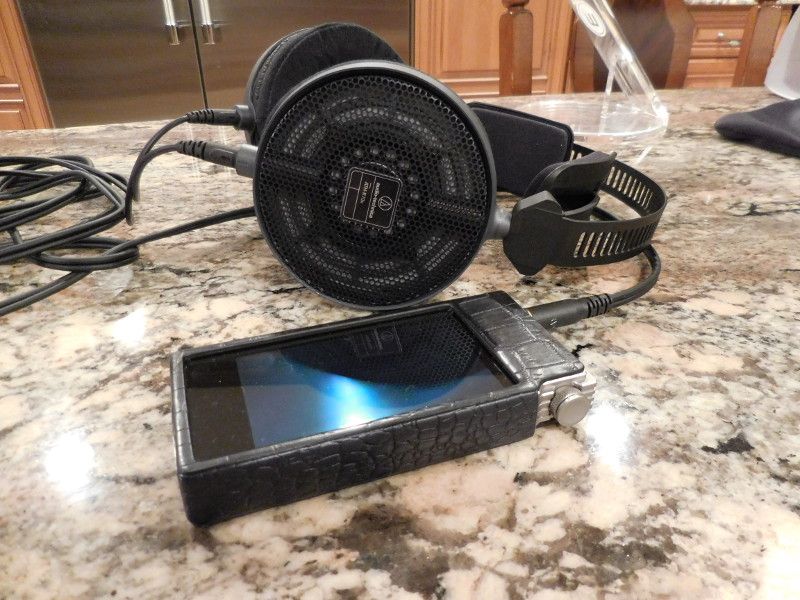
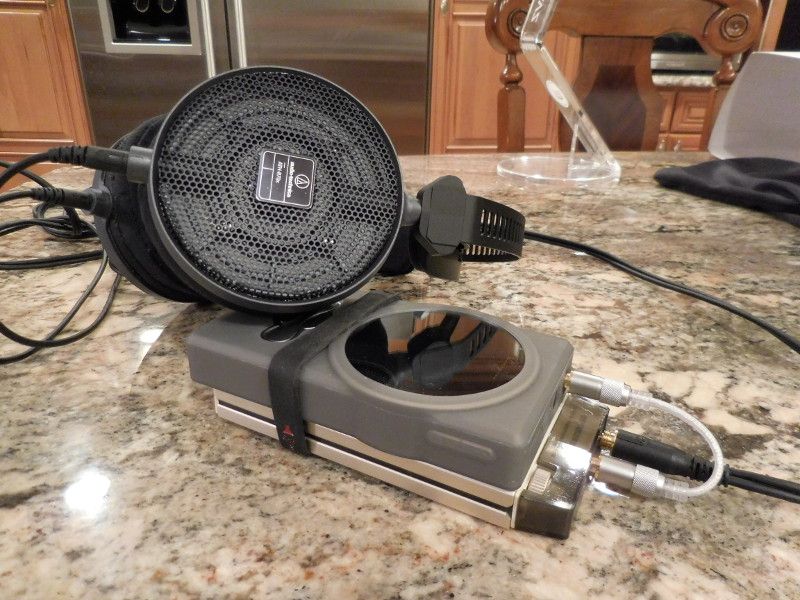
I started my review with a comment about AT lineup of the latest headphones offering a distinct sound signature, so here is a summary with a brief comparison to other AT models as well as a few other manufacturers.
R70x vs M70x - M70x sound is a lot flatter, bass is anemic in comparison, mids are thinner, treble is a little harsher, soundstage is surprisingly very similar, though width is a bit narrower.
R70x vs MSR7 - MSR7 has a little more bass quantity and in particular a stronger mid-bass punch, mids have a bit less clarity and pushed a little back, treble has a little more sizzle, soundstage depth is the same but width is a little narrower, and overall tuning is more balanced.
R70x vs M50x - M50x is more balanced and smoother, it has a deeper sub-bass and more mid-bass punch, mids are a touch lower, treble is not as extended, similar soundstage depth but width is a little narrower. Overall, not as detailed.
R70x vs HP150/HP200 - HP low end is very similar, closer to neutral level but not as tight, mids are a little more forward and a little brighter, treble has a few harsher peaks - overall spectrum is not as coherent, staging is very similar with HP200 open back design offering level of airiness that comes close but still not at the same level of natural transparency as R70x. In comparison, HPs are a bit more colored.
R70x vs MH40 - MH40 has a more balanced sound, stronger bass with a more mid-bass punch and some spillage into lower mids, mids are thicker, warmer, and more recessed, treble is smoother and not as extended. Also, nowhere never the same level of detail retrieval.
Conclusion.
It's very easy to make a decision which AT headphone is right for you: if you want more bass with a balanced sound and less top end extension you go for M50x; for a more balanced sound with a leveled off bass and a great treble extension you should look into MSR7; for a flat reference sound intended for accurate mixing/production rather than enjoyable listening, the M70x would be your best choice; and if you want a neutral transparent sound that is natural and accurate and don't mind open back design with a great soundstage expansion then R70x should be at the top of your list. For me personally, I have been enjoying neutral sound tuning more and more (even for EDM, crazy, uh?), and no longer prefer boosted bass or analytical treble. Unfortunately, my listening environment is not ideal for open-back headphones since I need more privacy, so I have been using MSR7 exclusively. But listening to R70x just blew me away with a perfection of natural sound quality. AT presents R70x as Professional Reference cans, but I think adding Audiophile in their description would really do a justice to these headphones since I found them to be essential tool not just for professional audio production but also for everyday listening pleasure on audiophile level!
I can’t imagine a better way to wrap up a series of my recent Audio-Technica reviews, featuring an impressive lineup of M50x, M70x, and MSR7, than by looking into their latest professional open back R70x headphones. In the past year AT has been on a roll with a lot of new releases, everything from in-ear to full size, and sometime it could be confusing and even overwhelming when you are presented with all these choices. Fortunately, AT simplified this decision task by offering their new full size headphones each with a distinct sound signature to suit different listening needs. Let me first take a closer look at R70x design and sound characteristics, and follow it up with a comparison to other models. Without a further ado, here is what I found.
Arrived in a rather large box, similar size to the latest M-models, the main focus of the cover image was to showcase the back of R70x earcup design. A mesh grill is very common in open back headphones to bring out characteristics of an airy sound, but AT went an extra mile to make this grill more transparent for a better visibility of internal design pattern. Otherwise, there is not much writing on the cover, just a bold image with a clear statement. Turning box to the side reveals another very interesting design element I haven’t seen before, a headband with a spring-loaded wing mechanism (more about it later). The back of the packaging box reveals a plethora of info about the design and sound signature (btw, found to be quite accurate – not the usual marketing hype), description of included accessories, and a detailed spec. I had to do a double take when I read 470 ohm driver impedance, but trust me – it’s not a typo.
Under the cover, you will find R70x in a foam egg crate setting with cutouts for earcups and headband wings. With this “egg crate” removed, there is a slim accessories box built into the base of this crate. It's a rather simple packaging but it felt already "airy" light and still perfectly secure!
Unboxing.






Moving on to accessories, you will find a straight 3.0m audio cable and 6.3mm adapter, and also a soft storage bag. Though it's rare to see 1/4" adapter nowadays, keep in mind these headphones are intended for professional use where pro amps and some outboard gear still uses 6.3mm headphone outputs. The same deal with a cable, it's rather long for portable use and more appropriate for desktop or studio application where you don't want to be restricted by a typical short 1.2m cable intended for a smartphone or DAP use. Still, if you want to take it on the go, maybe use a velcro to make it shorter or look for 3rd party replacement cables. The connector is their typical 2.5mm TRS with a twist-on lock, but there is a special "twist" to it. The cable splits going to L/R earcups and each connector is perfectly symmetrical so there is no designated Left or Right sides on the removable cable. Cleverly designed, each side of the cable has TRS connector with L/R/Gnd, and L/R earcups make contact only with corresponding channel. You can flip cable around and it still works correctly. My only gripe here, L/R markers inside of headband are very hard to spot.
Oh, and the storage bag... It has been a consistent "negative" comment in most of my AT full size headphone reviews (except for M70x), why not a hard shell case?!? So many headphones with a sub-par performance come with awesome storage cases, but AT with a stellar audio performance leaves storage to just a bag. In case of R70x, it's actually A BIG deal because these headphones don't fold flat, earcups swivel just a bit along y-axis for a more comfortable adjustment, but they don't swivel full 90deg for a compact flat storage. I was able to stuff R70x in the provided bag and it's actually quite a nice soft draw string pouch, but I would have to find an aftermarket case for a more secure storage if I want to transport these outside of the house.
Accessories.




I already mentioned a little bit about the design since it's a focus of the cover box - a beautifully crafted "transparent" aluminum honeycomb mesh covering the back of earcups and revealing the inside design. I absolutely LOVE this look which serves both aesthetic purpose and acoustic purpose to enable 3D open back expanded sound. The actual housing around it is made of a super lightweight carbon composite resin to improve structural rigidity while also providing a detailed transient response.
The earpads are made from a soft breathable fabric material which doesn't get hot or sweaty during extended listening session. They are very comfortable, plush, and have enough depth for my ears not to touch driver cover inside. The base of earpads is made from pleather and earpads are attached to the earcup slightly angled for a better seal behind your ears. The earcup attachment to the headband is at a single point with a restricted small degree of vertical swivel which helps in a more comfortable fitment around your head. Add to that a balanced clamping force from a steel spring headband, which btw I was able to bend/expand just a bit by applying some extra pressure to it, and at a about 210g of weight these were the most comfortable feather-light full-size headphones I have ever experienced.
Some might consider 210g is not feather-light relative to small IEMs, but for a full size headphones with a perfect distribution of weight - you can hardly even feel them. Another important factor of this comfortable fitment is their unique wing support. Again, this was a new one for me since I'm used to a traditional headband design with a height adjustment where the yoke attached to earcup extends to adjust to my head size. Here you have a spring-loaded short arm with a small swivel foam pad which self-adjusts to a perfect fitment. This way only foam side of those pads make a contact with a top of your head, headband itself is up in the air.
Design.








Audio-Technica labels R70x as their first pair of professional open-back reference headphones with high-efficiency magnets and pure alloy magnetic circuit design which reduces distortion and ensures accurate and extended high-frequency response. What does all this translates to? I'm hearing a neutral sound signature with a natural tonality and a very accurate retrieval of details, a great extension at both ends of the spectrum, and very non-fatigue sound (no sibilance or harsh analytical brightness). I know it's a mouthful, but I just never heard anything that sounded so crystal clear, accurate, and natural, and at the same time enjoyable for extended listening period. There are no cuts or boosts, no extra warmth of low end or extra sizzle at top end, just accuracy and quality.
Starting with a low end, there is no lack in bass response though it's more about quality than quantity. The bass does extends down to sub-bass level which is nicely balanced with mid-bass and both of which have a high level of accuracy with quantity approaching neutral level where you hear the bass rather than feel it, yet still it's tight and well controlled. Nothing is exaggerated, nothing spills into mids, and it's surgically separated from the rest of the frequency spectrum.
Mids are crystal clear, surprisingly not as thin as I expected with just a touch of warmth in lower mids to give them some body and high level of detail retrieval without too much of analytical brightness. Vocal delivery, both male and female, is crisp and organic.
Treble extends high up with a very crisp and clear delivery of sound that is not too harsh or sibilant. Any instrument that falls within treble range sounds natural and transparent, absolutely no harsh peaks.
With a help of open-back design, soundstage is open and airy, with a great width and depth. Sound separation is phenomenal with layering/separation of each individual instrument and vocals that could be easily singled out in a mix. Also, the imaging is very accurate with a precise position of every sound in the open 3D space. For studio mixing and mastering - this is a valuable tool that can substitute (though not replace) monitor speakers. At the same time, isolation is very poor since an open back design will let all sounds in from outside. The same is the other way around where sound leakage is very noticeable since there are no boundaries to confine a sound within earcups.
Amping is definitely something you need to consider, though I found a number of my portable DAPs to provide plenty of power to drive R70x to a comfortable listening level. For example, N6 and X3ii had no issue what so ever, while AK120ii and my Galaxy Note 4 needed to get closer to a volume ceiling level in order to drive them loud enough. The reason why I found amping to be necessary even in cases where my audio source had enough power is because it's not just about "loudness" but the actual "power" to drive it with authority to a full potential! The best pair up I found was with Cayin combo of N6 + C5 where soundstage expanded even further and bass became tighter and punchier.


I started my review with a comment about AT lineup of the latest headphones offering a distinct sound signature, so here is a summary with a brief comparison to other AT models as well as a few other manufacturers.
R70x vs M70x - M70x sound is a lot flatter, bass is anemic in comparison, mids are thinner, treble is a little harsher, soundstage is surprisingly very similar, though width is a bit narrower.
R70x vs MSR7 - MSR7 has a little more bass quantity and in particular a stronger mid-bass punch, mids have a bit less clarity and pushed a little back, treble has a little more sizzle, soundstage depth is the same but width is a little narrower, and overall tuning is more balanced.
R70x vs M50x - M50x is more balanced and smoother, it has a deeper sub-bass and more mid-bass punch, mids are a touch lower, treble is not as extended, similar soundstage depth but width is a little narrower. Overall, not as detailed.
R70x vs HP150/HP200 - HP low end is very similar, closer to neutral level but not as tight, mids are a little more forward and a little brighter, treble has a few harsher peaks - overall spectrum is not as coherent, staging is very similar with HP200 open back design offering level of airiness that comes close but still not at the same level of natural transparency as R70x. In comparison, HPs are a bit more colored.
R70x vs MH40 - MH40 has a more balanced sound, stronger bass with a more mid-bass punch and some spillage into lower mids, mids are thicker, warmer, and more recessed, treble is smoother and not as extended. Also, nowhere never the same level of detail retrieval.
Conclusion.
It's very easy to make a decision which AT headphone is right for you: if you want more bass with a balanced sound and less top end extension you go for M50x; for a more balanced sound with a leveled off bass and a great treble extension you should look into MSR7; for a flat reference sound intended for accurate mixing/production rather than enjoyable listening, the M70x would be your best choice; and if you want a neutral transparent sound that is natural and accurate and don't mind open back design with a great soundstage expansion then R70x should be at the top of your list. For me personally, I have been enjoying neutral sound tuning more and more (even for EDM, crazy, uh?), and no longer prefer boosted bass or analytical treble. Unfortunately, my listening environment is not ideal for open-back headphones since I need more privacy, so I have been using MSR7 exclusively. But listening to R70x just blew me away with a perfection of natural sound quality. AT presents R70x as Professional Reference cans, but I think adding Audiophile in their description would really do a justice to these headphones since I found them to be essential tool not just for professional audio production but also for everyday listening pleasure on audiophile level!







